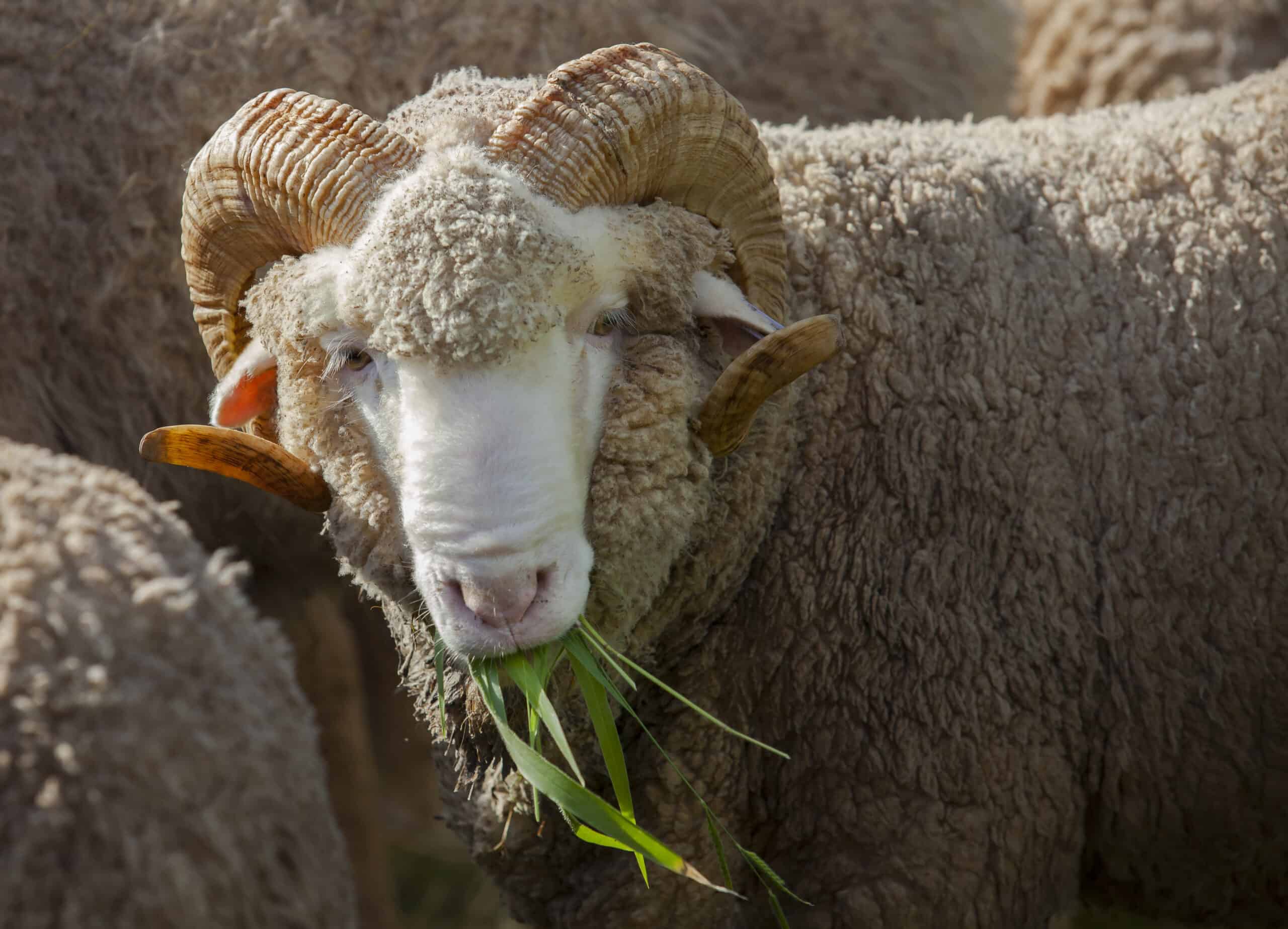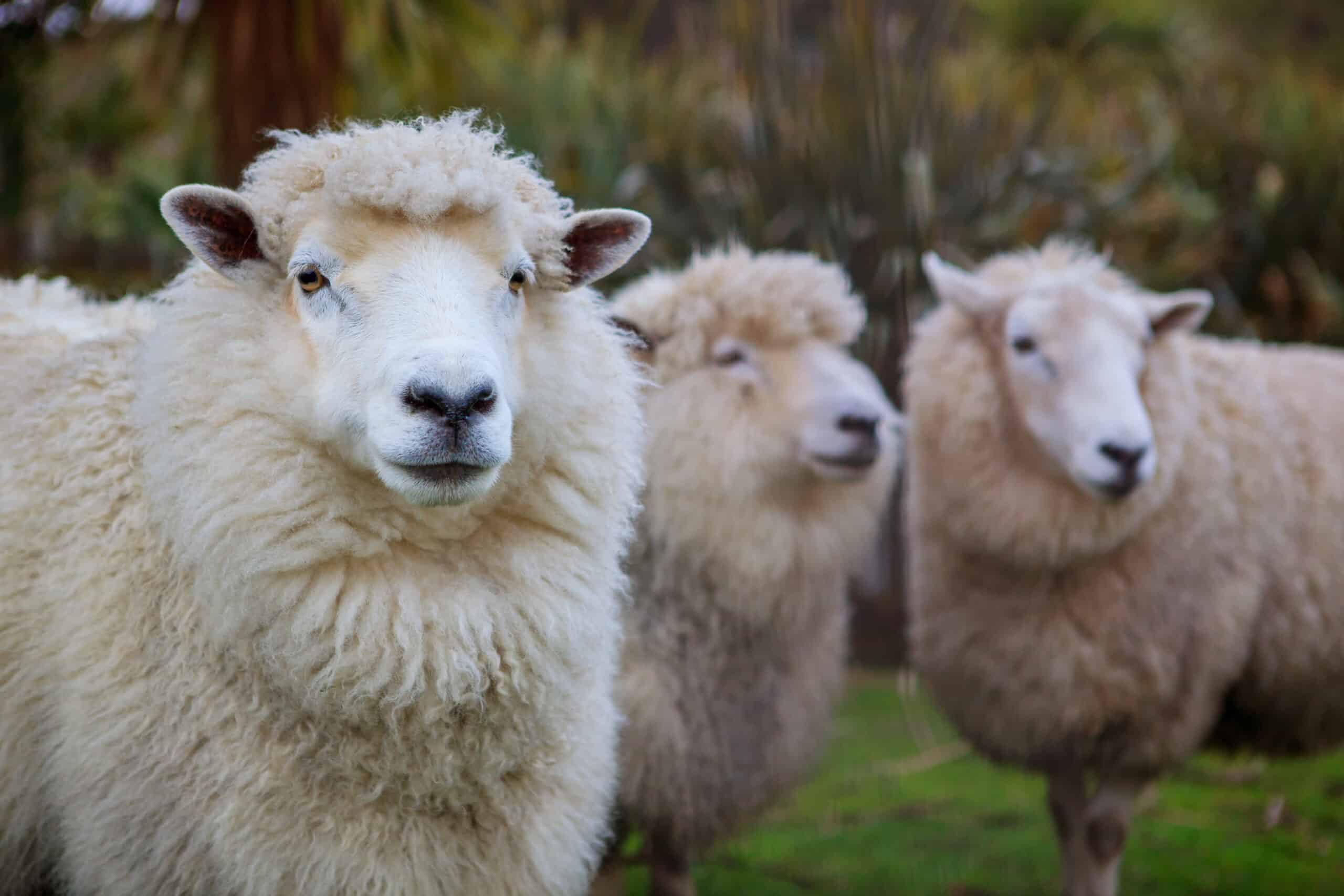Homesteaders raise Merino sheep for their high-quality, soft, fine wool as well as their meat. They are medium-sized and manageable which makes them popular for small-scale farming. With quality pasture, you can raise two Merinos per acre.
Keep reading to learn about Merinos and if they are a fit for your resources, including property, time, and budget, and production goals.
Merino Sheep
Like all sheep, they are social animals and do best in flocks. Raising a minimum of 5 sheep at a time is best. They also get along with other livestock, such as goats and alpacas, but these animals shouldn’t be used as a replacement for other sheep. Sheep are happiest around their own kind.
According to The University of Maine Cooperative Extension Publications, sheep likely respond more to proper care and attention than any other farm animal. This includes taking time to observe them and recognize their needs. Sheep aren’t just a “feed, water, and shelter” type of animal to bring on your farm.
For Merino sheep, grazing in open ranges is an excellent choice, promoting a healthy flock. Carefully selecting for desirable traits and culling to remove defects, farmers can optimize the wool quality and the animals’ well-being.
Wool Production
This breed produces high-quality wool year round. The wool is fine which makes it ideal for lighter items. It absorbs dye well.
However, not all Merino wool is ideal for clothing. The suitability for next-to-skin wear depends on the wool’s fineness. Wool from Merino sheep bred for meat won’t always be fine enough for comfortable clothing.
According to the American Craft Council, a Merino fleece produces around 8 pounds of wool. After separating it by color, a mill will clean, card, and spin it. The carding process involves separating, cleaning, and mixing pieces to create a straighter, continuous strand that’s ready to be spun.
After it’s washed, the original 8 lbs of wool is reduced down to around 4 – 5 pounds which can make approximately 4 throw blankets.
Before deciding on a specific Merino sheep breed, be sure to know your plan for the wool.
Caring for Wool Sheep
Shearing is important because a Merino sheep’s wool keeps growing. Without at least an annual shearing, the wool may become excessively heavy, leading to heat stress, musculoskeletal problems, wool blindness, matting, knotting, and increased susceptibility to flystrike.
Shearing Merinos
You’ll need to arrange for shearing once a year or once every 6 – 8 months. Some owners plan for two shearings every three years.
Also taking care to be sure the sheep can see is essential. The wool will grow around their eyes… so much so that there’s a term for it: wool blindness. Wool blindness puts their health and survival at risk.
You can learn how to shear a sheep yourself but it’s best to hire someone, especially when you are a new flock owner. Merinos can have skin folds which makes shearing more challenging. Leave it up to an expert for the first year or two.
Regular wool crutching is also necessary to keep their wool manageable and free from issues. It helps reduce staining and helps prevent flystrike.
Crutching involves cutting wool from the sheep’s tail area and between its hind legs. It can also include removing wool from the sheep’s head (wigging) and the male sheep’s groin area.
Caring for Merino Sheep
Whether you are interested in raising them for wool or meat production, there are things to know about caring for them well. They are pretty hardy and adapt well to various climates with proper care.
Nutritious Food & Water
To be their healthiest, Merino sheep require opportunities for grazing on nutritious pasture grasses and legumes. Rotational grazing is important as well. When the availability or quality decreases, you will need to supplement with hay and grains.
You will also need to ensure they have access to fresh, clean water at all times.
Hooves
Taking care of sheep hooves is vital for their health and productivity. Diseases in the hooves can harm the sheep’s overall well-being and lower their output. It’s important to regularly inspect hooves for any signs of disease or overgrowth.
According to Ohio State University’s OSU Sheep Team, sheep who graze on rocky, dry ground may need less hoof care than sheep on softer, moist soil. When sheep are in climates and areas with lots of rain, it’s important to check their hooves more often than in dry areas.
Deworming
Internal parasites can be a major cause of financial loss for sheep farmers, especially in the spring and summer. Infestations can lead to lower production in ewes and lambs, resulting in reduced milk production and poor weight gain. In severe cases, it can even cause death.
In the past, it was typical for sheep farmers to treat sheep with dewormers every 3 – 4 weeks as prevention.
However, experts no longer recommend deworming sheep as prevention. You are not supposed to deworm following a calendar schedule. They also advise against deworming all animals in a group at the same time.
The University of Maryland Extension explains that dewormers (called anthelmintics) are anti-parasitic drugs. When you give them to sheep routinely, they cause worms (especially the barber pole worm) to develop resistance to the dewormer. They state that you should only use them to treat the problem.
Speak to your large animal veterinarian. Remember: Frequent exposure to the same dewormer can lead to worm resistance to the medication.
Overall Health Care
Merino sheep have skin folds which can be prone to insect infestation and infection. Some Merino breeds, such as Delaine sheep, have less than others.
Flystrike also called myiasis, is something to watch for in sheep. Flystrike is a condition where flies lay eggs on the sheep’s skin, usually in damp wool or in open wounds. The maggots will eat the sheep’s flesh, causing wounds and possible infections if not treated.
This condition is common in warm or humid climates. Crutching, tail docking, and keeping sheep dry and in a clean environment helps prevent it. Consult a large animal vet in order to treat it.
Socialization
I mentioned this earlier but it’s important to remember that sheep are social and will be happier in a flock than alone or in a pair. If you don’t have room at least 5 sheep on your homestead, consider another animal to raise for its utility.
Merino Ewes
The females are valued for their high-quality wool. Some breeds of Merino ewes have horns that are straight and short. Some are polled (no horns).
Merino ewes are known for their relatively easy birthing process. They give birth to 1 – 2 lambs per year, in the spring. They have a strong maternal instinct. Post-lambing care includes checking the health of the ewes and lambs, ensuring lambs are nursing properly and managing any complications immediately.

Merino Rams
Larger than the females, the males can be more aggressive, especially when it’s breeding season. Homesteaders who Merino rams do mostly for breeding purposes. They provide wool but their fleece is typically coarser than wool from the females.
Hobby farmers do not have to keep a ram on their farm for breeding. Especially for those new to raising livestock, there are other practical and cost-effective options.
When starting with Merino sheep on a farm, it’s common to begin with a small flock of ewes and a ram for breeding or to purchase lambs to raise. The choice depends on the farm’s focus (wool, meat, or both) and the farmer’s experience level.
Lambs
Merino sheep are seasonal breeders, with the majority of breeding activity occurring in the fall. This timing ensures that lambs are born during the spring, benefiting from better weather and more abundant pasture.
Merino lambs are known for their rapid growth and ability to convert feed into body weight efficiently. This makes them suitable for wool and meat production.
Breeding & Reproduction
Breeding Merino sheep involves the standard practices seen in sheep farming. The pregnancy period for a Merino ewe is about 152 days.
One ram is usually capable of breeding with up to 100 ewes, though this can vary based on the ram’s age, experience, and physical condition. However, many sheep owners do not keep a ram because of the costs and practicality.
These options eliminate or reduce the need to care for and maintain a ram year round.
Artificial insemination (AI): This method allows farmers to introduce desirable traits and genetics into their flock.
Ram lease or share: Another option is to lease or share a ram with other farmers during the breeding season. This reduces the cost and responsibility of year-round ram care while facilitating natural breeding.
Merino Sheep History
Known for their superior wool Merino sheep origins trace back to Spain in the early 12th century. They are a descendant of the Mouflon, a type of wild sheep. Merinos are characterized by their medium stature and distinctive white legs and faces.
Australia is renowned for meticulous selective breeding, leading to the production of the world’s highest quality wool.
Merino Sheep Breeds
Depending on the Merino breed, their wool fibers vary between 65 to 100mm, according to Silverlight.
Saxon Merino sheep yield around 3 to 6 kilograms (6 – 12 pounds) of wool annually. Peppin Merino can produce as much as 18 kilograms (40 pounds) of wool each year.
There are many There are many Merino sheep breeds. Depending on the breed, they can be polled or horned.
- Booroola
- Delaine: There are A, B, and C types; type A is small (85 – 100 pounds) and not raised for meat or commercial lamb and wool production. Type B Delaine ewes weigh 100 – 120 pounds with a 14 – 18 pound fleece
- Fonthill
- Merinofleischschaf / German mutton or Merino mutton: Adapts to many climates and conditions; good meat yield
- Medium-Wool: Mostly raised for wool but considered dual purpose; this is the most popular Merino breed raised in Australia
- Merinolandschaf / Merino landsheep: Another German Merino breed; good meat yield
- Merinolangwollschaf / Merino longwool: Third German Merino; good meat yield
- Poll Merino: No horns (“polled”); medium to large in size; prized for their wool but considered dual purpose; strong animals; hardy in most all climates. Poll rams and wethers are less prone to poll strike than most other horned Merino sheep
- South African Meat Merino (SAMM): Good for dual purpose; developed in South Africa to be a hardy, polled dual-purpose breed, bred specifically to produce a slaughter lamb at an early age (77 lb at 100 days old). Now they are found across the world. Ewes have high milk production and produce produce 7.7 lb to 9.9 lb of medium-to-strong wool. When mature, ewes grow to 210 pounds; rams to 220+ pounds.
- South African Mutton
- Strong Wool
Other sheep breeds to consider raising for wool and meat are:
Raising Merino Sheep
Thinking about the goals for your farm will help narrow down if you want to raise livestock. Are you looking for wool or a sustainable meat source? Have you cared for livestock or any animals before?
Sheep are easy to raise but they require proper care daily. If you do decide on a wool sheep breed and are considering Merino sheep, learn more about wool so you can get the best Merino breed for what you want to accomplish.
Keep reading to learn more about raising sheep:
Featured image credit of Merino sheep ~ Yay Images, khunaspix

